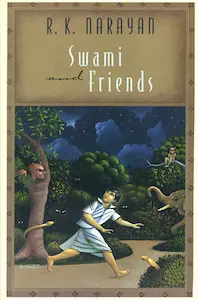Swami and Friends - Summary
R.K. Narayan

Introduction
“Swami and Friends” is a captivating novel written by R.K. Narayan that takes readers on a nostalgic journey through the life of a young boy named Swaminathan and his group of friends in the fictional town of Malgudi. Set in pre-independence India, this coming-of-age story explores the challenges, adventures, and friendships that shape Swami’s childhood. Through vivid storytelling, Narayan skillfully portrays the innocence, humor, and complexities of adolescence, making “Swami and Friends” a timeless classic.
Background and Setting
The novel is set in the idyllic town of Malgudi, a fictional place that serves as the backdrop for many of R.K. Narayan’s works. Malgudi, with its dusty streets, bustling marketplaces, and diverse characters, mirrors the essence of small-town India during the early 20th century. The town’s charm and simplicity provide an ideal setting for Swami and his friends to embark on their adventures and navigate the challenges of growing up.
Swami’s World
Swaminathan, affectionately known as Swami, is a ten-year-old boy who serves as the protagonist of the story. Swami’s world revolves around his family, school, and most importantly, his friends. Narayan masterfully captures the essence of Swami’s character, portraying his innocence, curiosity, and mischievous nature. Swami’s vivid imagination often leads him into amusing and sometimes troublesome situations, providing readers with delightful anecdotes throughout the novel.
The Power of Friendship
One of the central themes in “Swami and Friends” is the power of friendship. Swami’s group of friends, including Rajam, Mani, and Sankar, play a crucial role in shaping his experiences and worldview. Each friend brings a unique perspective and personality to the group, creating a dynamic and engaging narrative. Whether it’s standing up against bullies or embarking on thrilling escapades, Swami and his friends rely on their bond to navigate the challenges of childhood.
The Influence of Colonial Education
Another significant aspect of the novel is the influence of colonial education on Swami and his friends. The British education system, represented by the strict headmaster Mr. Ebenezar and the demanding teachers, becomes a source of frustration and rebellion for the young boys. Narayan skillfully portrays the clash between traditional Indian values and the imposed Western education system, highlighting the struggles faced by Swami and his peers as they try to find their place in a changing society.
Swami’s Coming-of-Age
As the story progresses, readers witness Swami’s gradual transition from childhood to adolescence, marked by his increasing awareness of the world around him. Swami’s encounters with societal issues, such as the freedom struggle and communal tensions, force him to confront his own beliefs and values. Narayan’s portrayal of Swami’s coming-of-age journey is both relatable and thought-provoking, as readers are reminded of their own experiences and the challenges of growing up.
Humor and Satire
Narayan’s writing is infused with humor and satire, adding an entertaining element to the narrative. Through witty dialogues, amusing incidents, and clever wordplay, the author keeps readers engaged and entertained throughout the novel. Swami’s humorous escapades, such as his attempts to avoid school or his comical encounters with his strict father, provide delightful moments of levity amidst the more serious themes explored in the story.
Cultural and Historical Context
“Swami and Friends” is set during a significant period in Indian history, providing readers with a glimpse into the social and political climate of the time. The novel subtly touches upon the Indian freedom struggle, communal tensions, and the impact of colonial rule on Indian society. Narayan’s portrayal of these historical and cultural aspects adds depth and richness to the narrative, allowing readers to understand the context in which Swami’s story unfolds.
Lessons of Empathy and Understanding
Throughout the novel, Narayan emphasizes the importance of empathy and understanding. Swami’s encounters with people from different backgrounds and social classes teach him valuable lessons about compassion and acceptance. Whether it’s his interactions with his strict headmaster, his loyal servant, or his own family members, Swami learns to see beyond surface-level differences and appreciate the shared humanity in everyone.
The End of Innocence
As the novel reaches its climax, Swami’s world is shattered by a series of tragic events. These events force Swami to confront the harsh realities of life, marking the end of his innocence. Narayan’s poignant portrayal of Swami’s loss of innocence serves as a reminder of the inevitable transition from childhood to adulthood, where one must face the complexities and uncertainties of the world.
Conclusion
“Swami and Friends” is a captivating novel that beautifully captures the essence of childhood, friendship, and the challenges of growing up. R.K. Narayan’s storytelling prowess, combined with his keen observations of Indian society, make this novel a timeless classic. Through Swami’s adventures, readers are transported to a bygone era, where innocence and imagination intertwine with the realities of life. “Swami and Friends” is a must-read for anyone seeking a heartfelt and engaging tale that resonates with readers of all ages.